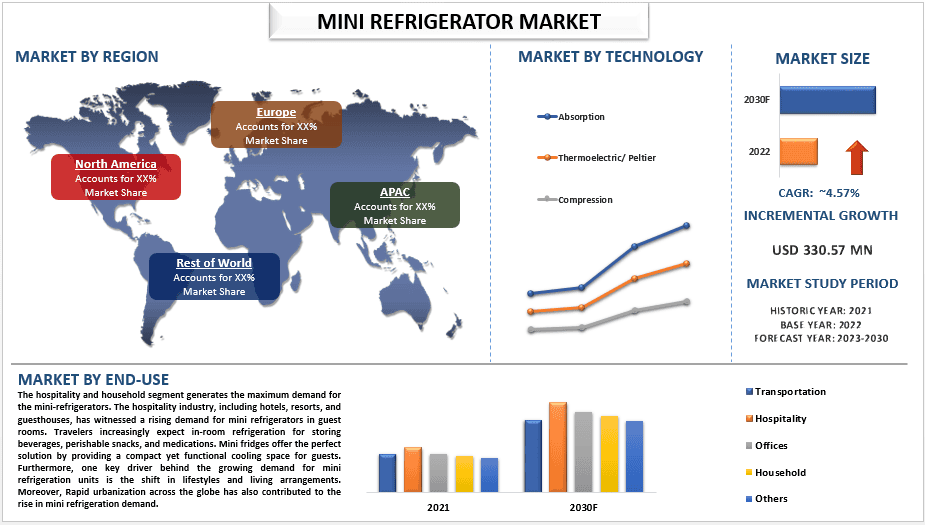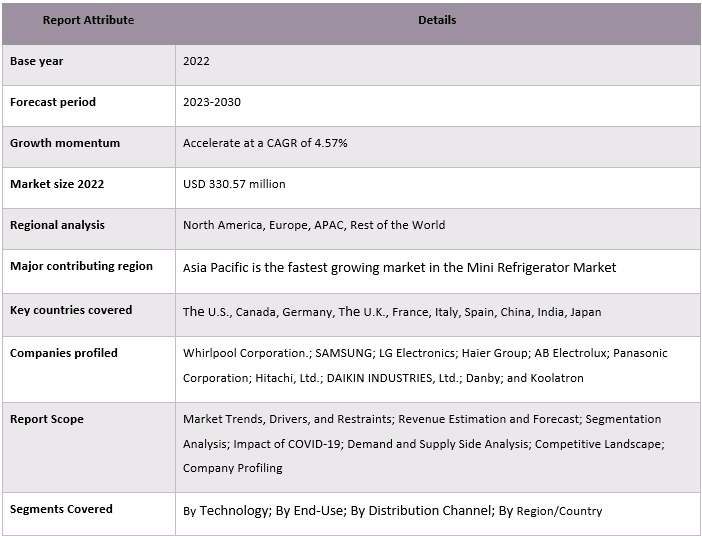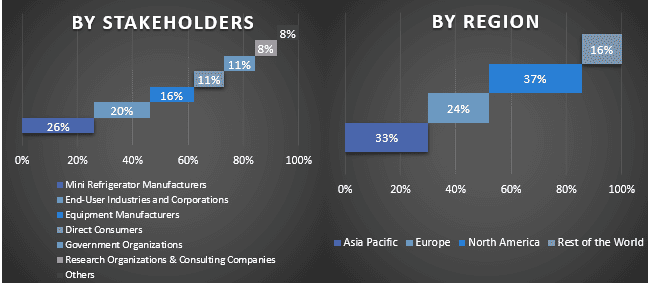- Home
- About Us
- Industry
- Services
- Reading
- Contact Us
Mini Refrigerator Market: Current Analysis and Forecast (2023-2030)
Emphasis on Technology (Absorption, Thermoelectric/Peltier, and Compression), End-User (Transportation, Hospitality, Offices, Households, and Others); Distribution Channel (Online Retail and Offline Retail); and Region/Country

The Mini Refrigerator Market was valued at 330.57 million in the year 2022 and is expected to grow at a steady rate of around 4.57 % during the forecast period (2023-2030), owing to the rising demand for convenience products, increased tours and traveling, and growing recreational purposes. Furthermore, as people’s lifestyles become more fast-paced and hectic, the need for convenience has increased. Mini refrigerators provide a convenient solution for storing and accessing food and beverages at home, in offices, or even while traveling. They offer a compact and portable option for keeping items cool and fresh, eliminating the need for larger refrigeration appliances. Furthermore, the increasing trend of tours and traveling has influenced the demand for mini refrigerators as well. Travelers, whether on short trips or longer vacations, often require the ability to store perishable items such as snacks, drinks, or medications. Mini refrigerators provide a practical solution by keeping these items cool and readily available during travel. In addition to this, the makeup industry and the medical and pharmaceutical industries are contributing to the increased demand for portable refrigeration. In the makeup industry, especially for professional makeup artists, mini refrigerators are utilized to store temperature-sensitive products like creams, serums, and certain types of makeup that may require cooling. This ensures the longevity and quality of the products. Similarly, in the medical and pharmaceutical industry, mini refrigerators play a crucial role in storing temperature-sensitive medications, vaccines, and samples. Portable refrigeration units allow healthcare professionals to transport these items safely, maintaining their integrity and efficacy. This increasing demand for mini refrigerators from the medical industry can also be seen in the product launches that are catering to this need. For instance, in February 2022, Michelin announced the launch of its new LED-equipped portable mini refrigerator which can be used for offices, garages, vehicles, boats, campsites, tailgate parties, and several other end-uses.
Some of the major players operating in the market include Whirlpool Corporation.; SAMSUNG; LG Electronics; Haier Group; AB Electrolux; Panasonic Corporation; Hitachi, Ltd.; DAIKIN INDUSTRIES, Ltd.; Danby; and Koolatron. Several M&As along with partnerships have been undertaken by these players to facilitate customers with hi-tech and innovative products/technologies.
Insights Presented in the Report
“Amongst Technology, the Thermoelectric/Peltier Segment is Going to Witness Significant Growth During the Forecast Period (2023-2030).”
Based on technology, the market is segmented into absorption, thermoelectric/Peltier, and compression. The thermoelectric/Peltier-based mini refrigerator holds one of the fastest-growing segments in the market. The primary region that is responsible for this high growth rate includes efficiency where Peltier coolers operate according to the Peltier effect, which creates a temperature difference by transferring heat between two electrical junctions. This process allows for instant cooling using electricity at lower costs compared to traditional refrigerators. Furthermore, these refrigerators are significantly smaller and lighter in comparison to conventional compressor-based refrigerators. Their compactness makes them ideal for small apartments, dorm rooms, offices, camping trips, or even road trips. They fit seamlessly into tight spaces while providing adequate cooling performance, ensuring convenience and portability. In addition to this, thermoelectric/Peltier mini refrigerators have a diverse range of applications, adding to their appeal. Apart from storing food and beverages, these refrigerators can also be used to cool medications, cosmetics, or skincare products that require specific temperature control. Additionally, they can be utilized to store valuable electronic devices, preventing damage due to overheating. The versatility offered by this technology has made it immensely popular among not only homeowners but also professionals from various industries
“Amongst End-Use, the Hospitality and Household Segment holds the Majority of the Segment of the Market.”
Based on end-use, the market is segmented into transportation, hospitality, offices, households, and others. The hospitality and household segment generates the maximum demand for the mini-refrigerators. The hospitality industry, including hotels, resorts, and guesthouses, has witnessed a rising demand for mini refrigerators in guest rooms. Travelers increasingly expect in-room refrigeration for storing beverages, perishable snacks, and medications. Mini fridges offer the perfect solution by providing a compact yet functional cooling space for guests. Furthermore, one key driver behind the growing demand for mini refrigeration units is the shift in lifestyles and living arrangements. Moreover, Rapid urbanization across the globe has also contributed to the rise in mini refrigeration demand. In densely populated urban areas, space comes at a premium. Mini fridges allow residents to maximize the limited space they have without sacrificing the convenience of having food and beverages readily available. Additionally, the ease of transport and versatility of mini-fridges make them attractive options for urban dwellers who frequently move or relocate. In addition to this, the increasing adoption of micro-home concepts, mobile homes, and the growing popularity of RVs has led to a higher demand for compact and portable appliances, including mini-refrigerators.
“North America is one of the Largest Market for Mini Refrigerators across the Globe and holds the Majority of the Market Share of Mini Refrigerators.”
North America holds most of the market share in the mini refrigerators segment globally. The primary factor responsible for this high market share includes evolving lifestyles, where the fast-paced and dynamic lifestyle of consumers in this region has contributed to the growth in the demand for mini refrigeration. With the rising number of individuals living in smaller apartments, dormitories, offices, or shared spaces, the need for compact refrigerators that maximize space and convenience has surged. Furthermore, another driver fueling the trend of mini refrigerators is the increasing demand for compact beverage storage solutions. Many consumers, particularly those who enjoy hosting social gatherings or have home bars, are opting for mini fridges dedicated solely to storing beverages. Moreover, recreational activities such as camping, road trips, picnics, and outdoor sports have become increasingly popular in North America. People are seeking ways to escape the confines of their homes and explore the beautiful landscape that the region has to offer. This trend has created a demand for appliances that can store food and beverages while on the go, leading to the rising mini refrigerator sales in the North American market.
Mini Refrigerator Market Report Coverage

Reasons to buy this report:
- The study includes market sizing and forecasting analysis validated by authenticated key industry experts.
- The report presents a quick review of overall industry performance at one glance.
- The report covers an in-depth analysis of prominent industry peers with a primary focus on key business financials, product portfolios, expansion strategies, and recent developments.
- Detailed examination of drivers, restraints, key trends, and opportunities prevailing in the industry.
- The study comprehensively covers the market across different segments.
- Deep dive regional level analysis of the industry.
Customization Options:
The global Mini Refrigerator market can further be customized as per the requirement or any other market segment. Besides this, UMI understands that you may have your own business needs, hence feel free to contact us to get a report that completely suits your requirements.
Table of Content
Research Methodology for the Mini Refrigerator Market Analysis (2023-2030)
Analyzing the historical market, estimating the current market, and forecasting the future market of the global Mini Refrigerator market were the three major steps undertaken to create and analyze the adoption of Mini Refrigerator in major regions globally. Exhaustive secondary research was conducted to collect the historical market numbers and estimate the current market size. Secondly, to validate these insights, numerous findings and assumptions were taken into consideration. Moreover, exhaustive primary interviews were also conducted, with industry experts across the value chain of the global Mini Refrigerator market. Post assumption and validation of market numbers through primary interviews, we employed a top-down/bottom-up approach to forecasting the complete market size. Thereafter, market breakdown and data triangulation methods were adopted to estimate and analyze the market size of segments and sub-segments of the industry pertains to. Detailed methodology is explained below:
Analysis of Historical Market Size
Step 1: In-Depth Study of Secondary Sources:
A detailed secondary study was conducted to obtain the historical market size of the Mini Refrigerator market through company internal sources such as annual reports & financial statements, performance presentations, press releases, etc., and external sources including journals, news & articles, government publications, competitor publications, sector reports, third-party database, and other credible publications.
Step 2: Market Segmentation:
After obtaining the historical market size of the Mini Refrigerator market, we conducted a detailed secondary analysis to gather historical market insights and share for different segments & sub-segments for major regions. Major segments are included in the report as technology, end-use, and distribution channels. Further country-level analyses were conducted to evaluate the overall adoption of testing models in that region.
Step 3: Factor Analysis:
After acquiring the historical market size of different segments and sub-segments, we conducted a detailed factor analysis to estimate the current market size of the Mini Refrigerator market. Further, we conducted factor analysis using dependent and independent variables such as technology, end-use, and distribution channels of the Mini Refrigerator market. A thorough analysis was conducted for demand and supply-side scenarios considering top partnerships, mergers and acquisitions, business expansion, and product launches in the Mini Refrigerator market sector across the globe.
Current Market Size Estimate & Forecast
Current Market Sizing: Based on actionable insights from the above 3 steps, we arrived at the current market size, key players in the global Mini Refrigerator market, and market shares of the segments. All the required percentage shares split and market breakdowns were determined using the above-mentioned secondary approach and were verified through primary interviews.
Estimation & Forecasting: For market estimation and forecast, weights were assigned to different factors including drivers & trends, restraints, and opportunities available for the stakeholders. After analyzing these factors, relevant forecasting techniques i.e., the top-down/bottom-up approach were applied to arrive at the market forecast for 2030 for different segments and sub-segments across the major markets globally. The research methodology adopted to estimate the market size encompasses:
- The industry’s market size, in terms of revenue (USD) and the adoption rate of the Mini Refrigerator market across the major markets domestically
- All percentage shares, splits, and breakdowns of market segments and sub-segments
- Key players in the global Mini Refrigerator market in terms of products offered. Also, the growth strategies adopted by these players to compete in the fast-growing market.
Market Size and Share Validation
Primary Research: In-depth interviews were conducted with the Key Opinion Leaders (KOLs) including Top Level Executives (CXO/VPs, Sales Head, Marketing Head, Operational Head, Regional Head, Country Head, etc.) across major regions. Primary research findings were then summarized, and statistical analysis was performed to prove the stated hypothesis. Inputs from primary research were consolidated with secondary findings, hence turning information into actionable insights.
Split of Primary Participants in Different Regions

Market Engineering
The data triangulation technique was employed to complete the overall market estimation and to arrive at precise statistical numbers for each segment and sub-segment of the global Mini Refrigerator market. data was split into several segments & sub-segments after studying various parameters and trends in the areas of the technology, end-use, and distribution channels in the Global Mini Refrigerator market.
The main objective of the Global Mini Refrigerator Market Study
The current & future market trends of the global Mini Refrigerator market were pinpointed in the study. Investors can gain strategic insights to base their discretion for investments on the qualitative and quantitative analysis performed in the study. Current and future market trends determined the overall attractiveness of the market at a regional level, providing a platform for the industrial participant to exploit the untapped market to benefit from a first-mover advantage. Other quantitative goals of the studies include:
- Analyze the current and forecast market size of the Mini Refrigerator market in terms of value (USD). Also, analyze the current and forecast market size of different segments and sub-segments.
- Segments in the study include areas of technology, end-use, and distribution channels.
- Define and analyze the regulatory framework for the Mini Refrigerator
- Analyze the value chain involved with the presence of various intermediaries, along with analyzing customer and competitor behaviors of the industry
- Analyze the current and forecast market size of the Mini Refrigerator market for the major region
- Major countries of regions studied in the report include Asia Pacific, Europe, North America, and the Rest of the World
- Company profiles of the Mini Refrigerator market and the growth strategies adopted by the market players to sustain in the fast-growing market
- Deep dive regional level analysis of the industry
Frequently Asked Questions FAQs
Q1: What is the current market size and growth potential of the global Mini Refrigerator market?
Q2: What are the driving factors for the growth of the global Mini Refrigerator Market?
Q3: Which segment has the largest share of the global Mini Refrigerator market by Technology?
Q4: What are the emerging technologies and trends in the global Mini Refrigerator market?
Q5: Which region will dominate the global Mini Refrigerator market?
Q6: Who are the key players operating in the global Mini Refrigerator market?
Related Reports
Customers who bought this item also bought










